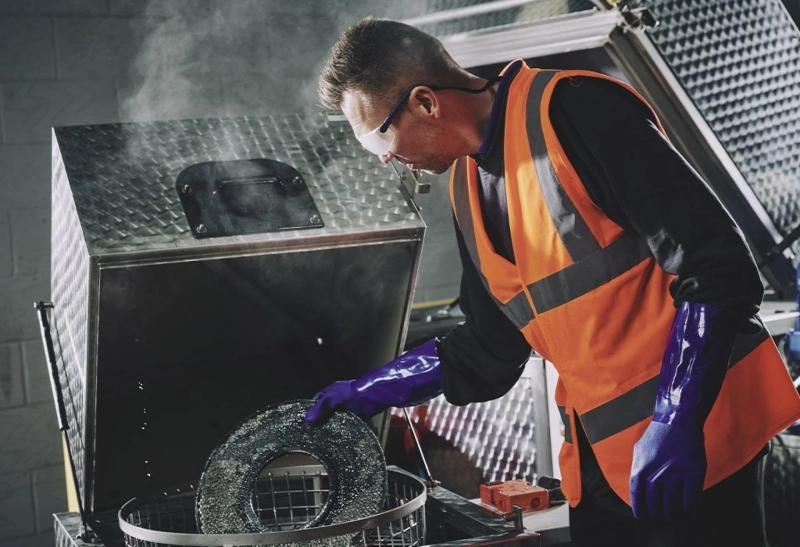Industrial parts cleaning plays a pivotal role in the manufacturing industry. It contributes significantly to the efficiency of the production process and the quality of end products. As manufacturers strive for higher standards and greater operational efficiency, the choice of cleaning techniques and solutions becomes increasingly critical.
Why is it Important?
Effective parts cleaning is a fundamental aspect of manufacturing operations across diverse industries, including automotive, aerospace, electronics, and medical devices. Its primary objectives are:
Removing Contaminants - During the manufacturing process, parts and components often accumulate contaminants such as grease, oils, dirt, rust, and machining residues. These contaminants can impair the functionality of the parts, compromise product quality, and lead to operational issues.
Ensuring Product Quality - Clean parts are essential for maintaining product quality and reliability. Any residual contaminants or foreign substances can lead to defects, product failures, or safety concerns, which can result in costly recalls and damage to a company's reputation.
Improving Efficiency - Clean parts facilitate smoother assembly processes, reduce friction, and minimize wear and tear. This, in turn, enhances manufacturing efficiency, reduces downtime, and extends the lifespan of equipment and components.
Meeting Regulatory Standards - Many industries are subject to stringent regulatory standards and cleanliness requirements. Adherence to these standards is essential to ensure compliance and avoid legal and financial consequences.
What are Examples of Parts Cleaning Techniques and Solutions?
Many techniques and solutions are available, each tailored to specific needs and applications. The choice of method depends on factors such as the type of contaminants, the material of the parts, and environmental considerations. Some of the most commonly used are:
Aqueous Cleaning - Aqueous cleaning involves the use of water-based cleaning solutions, which are environmentally friendly and effective for removing a variety of contaminants. It is a versatile method suitable for cleaning a wide range of materials, including metals, plastics, and ceramics. Ultrasonic and spray cleaning systems are often employed for aqueous cleaning.
Solvent Cleaning - Solvent-based cleaning relies on the use of organic solvents to dissolve and remove contaminants. It is particularly effective for removing oils, greases, and organic residues. Solvent cleaning systems can be tailored to specific applications and are commonly used in precision cleaning processes.
Vapor Degreasing - Vapor degreasing is a technique that uses solvent vapors to clean parts. It is highly effective for removing heavy greases and oils from metal surfaces. Vapor degreasing systems are designed to minimize solvent waste and emissions.
Abrasive Blasting - Abrasive blasting involves the use of abrasive media, such as sand, glass beads, or plastic pellets, to remove contaminants and surface impurities. It is commonly used for cleaning and preparing surfaces for subsequent treatments, such as painting or coating.
Biodegradable Cleaners - As environmental concerns grow, biodegradable cleaning solutions have gained popularity in various commercial industries. These solutions are designed to be eco-friendly while maintaining high cleaning performance. They reduce the environmental impact of commercial parts cleaning processes and comply with sustainability goals.
How can These Improve Efficiency and Quality?
Specialized cleaning products and solutions for parts contribute significantly to manufacturing efficiency and product quality improvement. Here are some ways in which these products make a difference:
Precision Cleaning - These products are formulated to target specific contaminants while minimizing the risk of damage to delicate components. This precision ensures that contaminants are effectively removed without compromising the integrity of the parts.
Consistency - Automated parts cleaning systems, often coupled with specialized cleaning solutions, provide consistent and repeatable cleaning processes. This consistency reduces variability in product quality and ensures that every part meets the desired cleanliness standards.
Reduced Downtime - Efficient parts cleaning processes, enabled by specialized products, lead to reduced downtime in manufacturing operations. Clean parts move smoothly through the assembly process, minimizing delays and improving overall production efficiency.
Extended Equipment Life - Regular and effective parts cleaning can extend the lifespan of manufacturing equipment. By reducing wear and tear caused by contaminants, specialized cleaning products help manufacturers avoid costly equipment replacements and repairs.
Regulatory Compliance - Many commercial industries are subject to strict cleanliness standards and regulations. Using approved commercial parts cleaning products ensures compliance with these standards, reducing the risk of fines, litigation, and reputational damage.
Enhanced Product Quality - Clean parts lead to higher-quality end products with fewer defects. This, in turn, results in improved customer satisfaction, reduced warranty claims, and a stronger market position for manufacturers.



